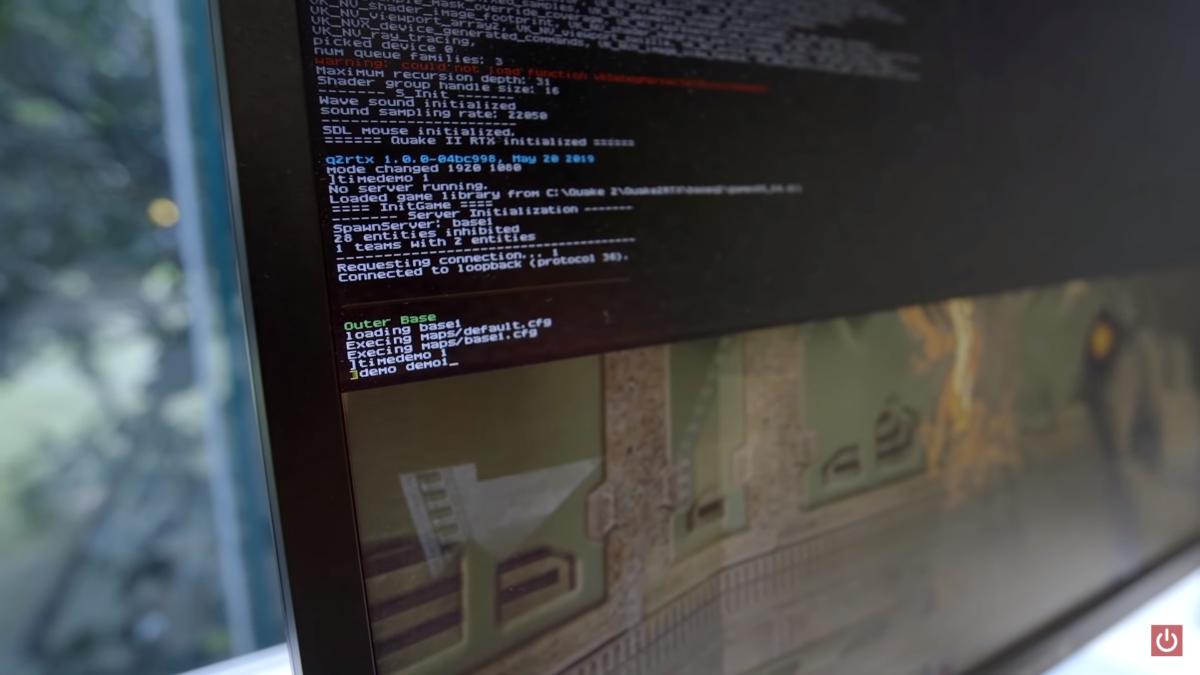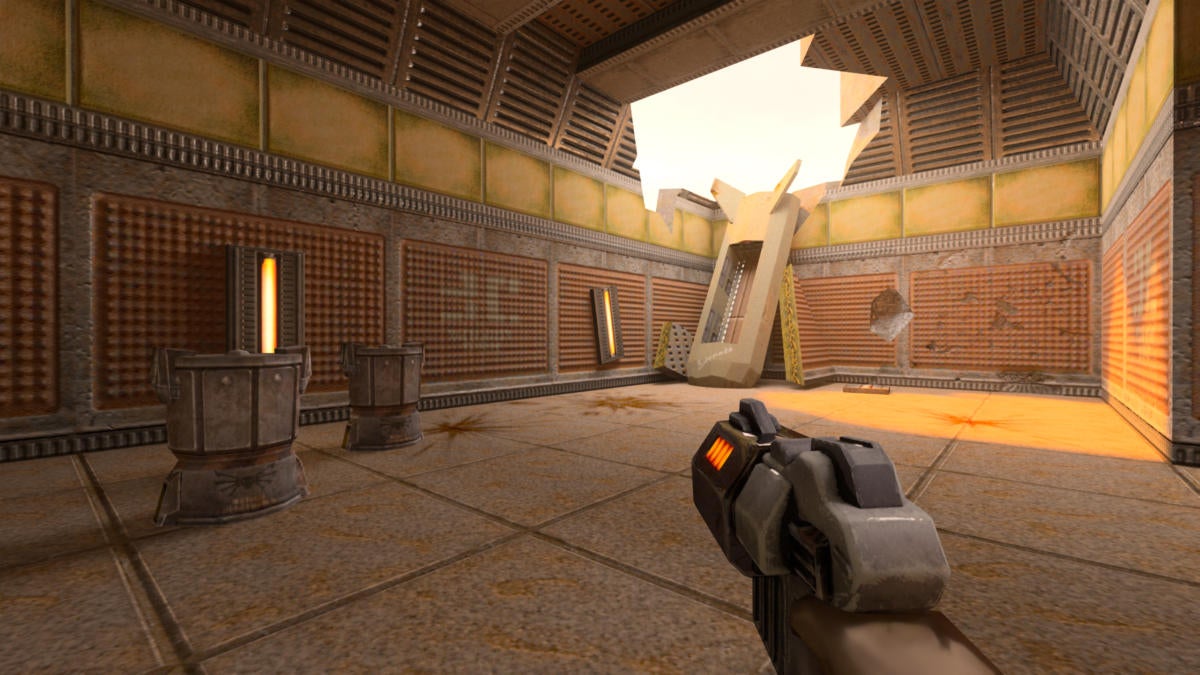We ran Quake II RTX on a GeForce RTX 2080 Ti card, and here’s how fast it was - tobiasfolisn
On June 6th you'll at long last be capable to get Nvidia's remastered Quake II RTX edition for free. And if you're wondering just how fast the game runs, we just found call at the oldest-school way practicable.
First, to pinch you up, Nvidia has taken iD's classic 1997-vintage gunman Quake II and lovingly updated it with a fully path-traced renderer. Spell you mightiness dismiss that as "just another game with hybrid shaft of light tracing" support, this is much to a higher degree that. At this juncture of ray tracing hardware functioning, most games use ray tracing meagrely and combine it with traditional raster techniques.
Nvidia's Quake II RTX remaster, however, renders everything past physically tracing light rays to create the scene. Such an undertaking with a moderne game's complexity isn't possible, but 1997's Quake II puts it within reach.
Nvidia gave us a unplanned to frolic with a neighboring-release variation of Quake II RTX during Computex, so we decided to see how next in fidelity the RTX version was.
Update: The final version seems to have changed the demo computer filename shown in the video, but we just tested IT on the free version Nvidia released this morning (download it here). Read on for the correct selective information.
Memories: Going way, way back to Quiver II
When we talk about Earthquake II, we're talking old-cultivate PC gaming, and old-schooltime graphics. In 1997, Matrox was still in the game, AMD hadn't yet bought ATI, and even Nvidia's GeForce didn't exist in time (its card at the time was the Riva 128). As a matter of fact, dozens of graphics companies were still competing at the time.
As if to prove how the world is on a time loop, everyone was quaking in their boots in fear of Intel's upcoming distinct graphics add-in, the i740 using the AGP port. The nonrepresentational wisdom among investors, technology analysts, and press was that Intel could do none ill-timed and would presently take over the discrete graphics grocery.
In 1997, though, PC gamers altogether wanted 3Dfx's Voodoo card (the Voodoo2 poster would come out a year after Temblor Cardinal).
 IDG
IDG Here's how you run a benchmark in Quake Cardinal RTX that way we did it in 1997.
How to benchmark Quake II RTX the 1997 way
Only old timers likely remember that Palpitate II had a constitutional bench mark, which quickly became the gaming benchmark to measure graphics cards (the term GPU hadn't been coined yet). What's cool is Nvidia's remastering of Quake II includes the original timedemo from 1997.
To discharge it, set u the game demo from Nvidia's website. The relinquish version includes three levels simply should be capable of running the Quake II collective-in benchmark. Configure the gamy for the solving and nontextual matter quality settings you need to test, then follow this key sequence:
- Press the tilde (squiggly line) key, typically at the overstep unexpended nook (under the function-key row) on standard QWERTY keyboards.
- Case timedemo 1
- Typewrite demo demo1
Those commands work in the Quake RTX version (which was built off of wreak by Christoph Schied for his Q2VKPT project).
If you just want to see how your copy of Quiver Two runs today, you Crataegus laevigata have to type this instead:
- timedemo 1
- demomap demo1.dm2
For an alternative demo correspondenc, type demomap demo2.dm2 instead.
Seism II wish now lam the short prospect. Pressing the tilde key once again leave show an average frame value from the scarper.
Update: The final demo released past Nvidia this morning seems to have jettisoned the present map simply you potty still run the pre-canned benchmark by typing:
- timedemo 1
- demomap q2demo1.dm2
In style Update: The command to run the exhibit has altered once again. Again wont the ~ key to down the console and run the original pre-canned benchmark aside typing:
- timedemo 1
- demonstrate q2demo1.dm2
 Nvidia
Nvidia So how scurrying is information technology?
Along a GeForce RTX 2080 Cordyline terminalis with a not-quite-final version of Palpitate II RTX, we saw roughly 97 fps at a resolution of 1920×1080, with visual quality set to pinched. For comparison, we sawing machine about 419 fps in Quake II, set to 1920×1080 with 8x property filtering and multisampling turned off, using the OpenGL 3.2 renderer on a Core i7-9750H laptop with a GeForce GTX 1660 Ti GPU. We had to spot the Steam version maiden using the Yamagi bandage.
If you'Ra underwhelmed by 97 fps on a $1,200 GeForce RTX 2080 Te card, recollect what's going on here. The game is implementing a fully path-traced renderer and is computationally pricy to run. It's a proficiency that's real only been victimised in 3D movies to date, and fairly fresh, too.
It also yields some beautiful effects. Glass over Windows and weewe in Quake II RTX obviously seem like dark and day from the original version. So if you'atomic number 75 going to snark about "sole 97 fps" on a GeForce RTX 2080 Te, bed that a biz session of Quake II RTX will easily provide more ray-copied frames than a full-length animated movie, and in echt time, excessively.
If you're planning along running Quake Deuce RTX, you'll probably want to pair it with the Game Make GeForce drivers too (available here).
It's like 1997 finished again!
So quite than use this Eastern Samoa an chance to create yet other hot postulate on the State of beam tracing in now's games and hardware, instead wind the clock back 22 geezerhood and crank up this gem of a game.
Source: https://www.pcworld.com/article/397542/quake-ii-rtx-on-a-geforce-rtx-2080-ti-card-ray-tracing-performance.html
Posted by: tobiasfolisn.blogspot.com


0 Response to "We ran Quake II RTX on a GeForce RTX 2080 Ti card, and here’s how fast it was - tobiasfolisn"
Post a Comment